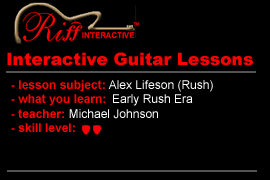Scroll through the lesson and click on notation/video/audio links to load the interactive players.
Please subscribe to get full access to all lessons for only $7.95/month PLUS 1 week free trial.

Riff Interactive lessons are
LESS expensive and
MORE interactive than alternatives!
More Info
|
|

Teacher: Welcome class to the lesson on the
style of Alex Lifeson of Rush. This lesson will cover more of his early days
with Rush, picking up from Fly By Night and Caress of Steel era. This is
the time when drummer Neil Peart joined the band and they branched out into
more of a progressive rock style, verses the early rock style used on the 1st
album. Notice there are more music transitions. The lead will often follow
these changes as you hear in the lesson sample.
Lesson Sample - Lowband - 1 Meg
Lesson Sample -
Highband - 2.7 Meg
Teacher: Let's jump
into the lesson! Here's the opening
riff.
Part 1 -
Intro
Part 1 -
Intro
Teacher:
This riff starts with a basic pull-off to G, and the ascending the 5th, 6th and
7th frets on the 5th string. Here's the jam track.
Looping Jam Track
1 - Lowband
Teacher:
This intro sets the mood for the main riff. Here's the riff.
Part 1 - Riff
1
Part 1 - Riff 1
Teacher: This section basically
uses 5 chords, or otherwise known as "power chords". Alex would uses these
chords in a very creative and melodic way, while the bass and drums would play
counter parts. Rush would arrange the songs so all the instruments would fit
together, allowing the drums or bass to riff out at specific times. Alex would
also use open chords to contrast the 5 chords as well. Notice how you play the
open G and other chords towards the end of this section.
Teacher: Here's the entire phrase using all
parts.
Looping Jam
Track 2b - Lowband
Teacher:
OK, let's jump to a solo you can play over this section
Part 1 -
Solo 1
Part 1 - Solo
1
Teacher:
This is a cool sounding lick, that uses open strings notes as part of a
hammer/pull-off sequence. The scale is the F# Phrygian. Here's the scale so you
can get an idea of the pattern.
F# Phrygian
Teacher:
You can see in this pattern how you can use open notes for the
hammer/pull-offs. Here's the next part of the solo.
Part 1 -
Solo 2
Part 1 - Solo
2
Teacher:
This is the solo you play over the open chords I gave you in the jam track. The
solo uses the E Minor (Aeolian) scale. Notice how the licks sound majestic while
playing of the chords. Here's the E Minor scale pattern.
E Minor
Scale
Teacher:
Later in the last jam track you have more open chords, here's the melody you
would play over this section.
Part 1 - Solo 3
Part 1 - Solo
3
Teacher:
Rush would also use dynamics in their arrangements to give their songs more
contrast. Adding an acoustic or clean guitar tone would help them achieve this
dynamic. Next is a mellow rhythm guitar pat.
Part 2 - Riff
1
Teacher: Here's the jam
track.
Looping Jam Track 3 - Lowband
Teacher: This
phrase starts with an A, then adding a 9th by adding the 4th finger on the 1st
string. Notice the use of the open E (1st string) as the pedal tone, which
drones throughout the chords at the beginning of the phrase. Bars 3 & 4 use
polytonal chords that look like a open D Major chord fingering. Next you will
play a solo over these chords. Here's the licks.
Part 2 -
Solo1
Part 2 - Solo
1
Teacher:
This solo uses the B Dorian, here's the scale pattern.
B
Dorian
Teacher: The next part uses chords that are in
octaves. Here's the part.
Part 3 - Riff 1
Teacher:
Easy chords as you can see, notice after you play the E barre on the 7th fret,
you then jump to the octave on the 14th fret. Here's the jam
track.
Looping Jam
Track 4a - Lowband
Teacher:
This should give you a better idea on how Rush arranged their songs during their
early progressive era. Time to go, see you next lesson!
bill:
thanks teacher, I will work on this
Teacher:
bye!
|
<< load notation from left
|
|
<< load audio from left
|
<< load audio from left
|